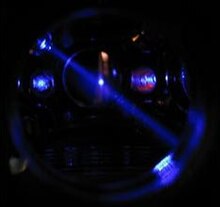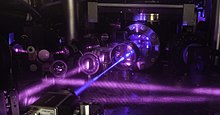Optical clock
[1] Several elements have been used in optical clocks, including magnesium, aluminum, potassium, calcium, rubidium, strontium, indium, ytterbium, mercury, and radium.
John L. Hall and Theodor W. Hansch shared the 2005 Nobel Prize in Physics for their contributions to optical clock development.
This problem has been solved with the development of self-referenced mode-locked lasers, commonly referred to as femtosecond frequency combs.
Additional desired features include properties that suppress external perturbations, for example stray electric fields, and availability of the atom for long-term use in a sealed system.
[16] The theoretical move from microwaves as the atomic "escapement" for clocks to light in the optical range, harder to measure but offering better performance, earned John L. Hall and Theodor W. Hänsch the Nobel Prize in Physics in 2005.
One of 2012's Physics Nobelists, David J. Wineland, is a pioneer in exploiting the properties of a single ion held in a trap to develop clocks of the highest stability.
At this stability, the two optical lattice clocks working independently from each other used by the NIST research team would differ less than a second over the age of the universe (13.8×109 years); this was 10 times better than previous experiments.
[24] In 2015, JILA evaluated the absolute frequency uncertainty of a strontium-87 optical lattice clock at 2.1×10−18, which corresponds to a measurable gravitational time dilation for an elevation change of 2 cm (0.79 in) on planet Earth that according to JILA/NIST Fellow Jun Ye is "getting really close to being useful for relativistic geodesy".
[25][26][27] At this frequency uncertainty, this JILA optical lattice clock is expected to neither gain nor lose a second in more than 15 billion years.
Ye further commented "the most important potential of the 3D quantum gas clock is the ability to scale up the atom numbers, which will lead to a huge gain in stability" and "the ability to scale up both the atom number and coherence time will make this new-generation clock qualitatively different from the previous generation".
[1][45][46][47][48] The BIPM reported in December 2021 based on the progress of optical standards contributing to TAI the Consultative Committee for Time and Frequency (CCTF) initiated work towards a redefinition of the second expected during the 2030s.
[49] In July 2022, atomic optical clocks based on iodine molecules were demonstrated at-sea on a naval vessel and operated continuously in the Pacific Ocean for 20 days in the Exercise RIMPAC 2022.
[50] These technologies originally funded by the U.S. Department of Defense have led to the world's first commercial rackmount optical clock in November 2023.


